Faculty News
Alan Braddock returned to William & Mary in Fall 2020 after completing a yearlong research leave as a scholar-in-residence in the "Art and Ecology" cohort at the Getty Research Institute in Los Angeles, where he began work on a new book titled Implication: An Ecocritical Dictionary for Art History, which is under advance contract with Yale University Press. While on leave, he published two essays in different Routledge volumes, one on directionality in the art of Thomas Cole and another on the art of the global American Civil War, as well as two book reviews in Public Art Dialogue and RACAR respectively, and he was invited to give lectures at the Instituto de Investigaciones Estéticas de la Universidad Autónoma de México, the Graduate Center of the City University of New York, the Laguna Art Museum, and in an online conference hosted by the Freie Universität Berlin. By the end of this year, Prof. Braddock expects to complete the manuscript of his book Gun Vision: The First Avant-Garde in American Painting. In 2021, essays by him will appear in edited volumes to be published by Routledge, the Princeton University Art Museum, and the Terra Foundation for American Art. The Getty Research Institute has invited him to co-edit a new volume on art history and ecology to be published in 2024. At William & Mary, he continues to develop new curriculum connecting art history with the environmental humanities.
{{youtube:medium:left|O2zoro6JylM, The Spring 2020 Curatorial Project, "Scales of Chaos: The Dance of Art & Contemporary Science"}} Xin Conan-Wu taught the required practicum course for Art History majors “The Curatorial Project” in spring 2020, steering the class through a student-curated full-scale exhibition amid the covid-19 pandemic. The resulting exhibition, Scales of Chaos: The Dance of Art and Contemporary Science, responds to the COLL300 theme “Scale” from the perspective of Chaos Theory. She also launched a new topics course “Artistic Encounters: East-West” and served as a discussion group leader with the environmental studies in “China’s Green Transition”. In research, she completed the manuscript of a new book, The Lure of Supreme Joy: Place-Making and Self-Cultivation in Zhu Xi’s Pedagogy, which is currently under review.
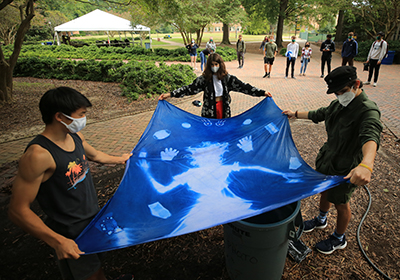 Eliot Dudik was the Artist in Residence at the Schoodic Institute at Acadia National Park for 6 weeks this summer. The Schoodic Institute is the largest National Park Service Research Learning Center in the US, and is focused on environmental research that supports the national park and local communities that are reliant on natural resources. While in residence, part of his research included collaborating with scientific researchers who were working in the park. This opportunity has also expanded to be a longer-term collaboration in which he plans to continue working with the Institute, these researchers, and other scientists who were not able to travel to the park this year because of the pandemic. Further, he is working with the Schoodic Institute to set up an internship program, which he hopes to be an ongoing opportunity for William & Mary students. To get things started, Eliot arranged for Art & Art History alum and current MFA student in Photography at Syracuse University, Linda Moses, to come to the Institute with him this summer to help lay the groundwork for this future internship opportunity.
Eliot Dudik was the Artist in Residence at the Schoodic Institute at Acadia National Park for 6 weeks this summer. The Schoodic Institute is the largest National Park Service Research Learning Center in the US, and is focused on environmental research that supports the national park and local communities that are reliant on natural resources. While in residence, part of his research included collaborating with scientific researchers who were working in the park. This opportunity has also expanded to be a longer-term collaboration in which he plans to continue working with the Institute, these researchers, and other scientists who were not able to travel to the park this year because of the pandemic. Further, he is working with the Schoodic Institute to set up an internship program, which he hopes to be an ongoing opportunity for William & Mary students. To get things started, Eliot arranged for Art & Art History alum and current MFA student in Photography at Syracuse University, Linda Moses, to come to the Institute with him this summer to help lay the groundwork for this future internship opportunity.
His most recent, long-term project, Paradise Road, was featured on NPR's The Picture Story on July 11th.
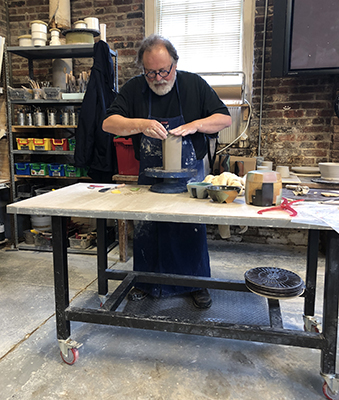 Mike Jabbur was scheduled to present work as part of the “Tectonic Plates” exhibition at Arrowmont School of Arts and Crafts in Gatlinburg, TN, as part of the Utilitarian Clay VIII symposium. He also co-organized three exhibitions for the NCECA ceramics conference, which was scheduled to be held in Richmond, VA. The symposium and conference were both canceled due to the pandemic, however one conference exhibition, “Re-presentations” did open at Randolph Macon University. At William and Mary, he taught ceramics courses, sat on two honors theses, and served as Associate Chair of Art & Art History. He also organized a ceramics workshop and retrospective exhibition in the Andrews Gallery for David Crane.
Mike Jabbur was scheduled to present work as part of the “Tectonic Plates” exhibition at Arrowmont School of Arts and Crafts in Gatlinburg, TN, as part of the Utilitarian Clay VIII symposium. He also co-organized three exhibitions for the NCECA ceramics conference, which was scheduled to be held in Richmond, VA. The symposium and conference were both canceled due to the pandemic, however one conference exhibition, “Re-presentations” did open at Randolph Macon University. At William and Mary, he taught ceramics courses, sat on two honors theses, and served as Associate Chair of Art & Art History. He also organized a ceramics workshop and retrospective exhibition in the Andrews Gallery for David Crane.
Brian Kreydatus exhibited in several group exhibitions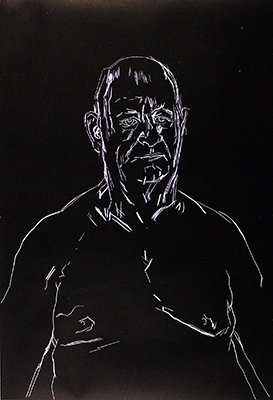
including the Fourth Annual Printmaking Triennial, Belgrade, Serbia (moved online due to pandemic) and the Boston Printmakers: 2019 North American Print Biennial, Jewett Art Gallery, Wellesley Art Gallery, Wellesley, MA where his print “Robin” received the The Charbonnell 2019 Biennial Materials Award by Savoir-Faire. Since the pandemic, Professor Kreydatus has been exploring hand-printing through a series of relief prints based on his family’s reaction to the shutdown.
John Lee recently had a solo show: “Arm’s Length Intimacy” at the First Street Gallery in New York (October 23rd-November 19th, 2019. Lee was also in group shows, including , “Mundane: The Ordinary Everyday” at Manifest Gallery in Cincinnati, Ohio (January 24th-February 21st, 2020), and “The Tenth Anniversary Exhibit” at Linda Matney Gallery in Williamsburg, Virginia (September 17th-October 10th, 2020).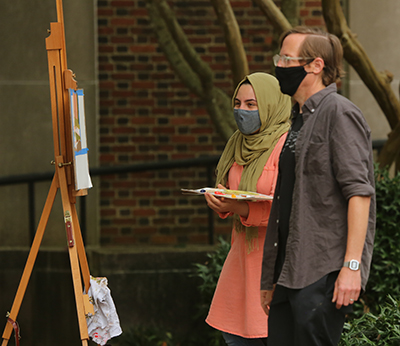
Catherine Levesque published an essay, “’Imitation and Its Discontents’: Hercules Segers’s Window,” in a festschrift for David A. Freedberg and a review for the Renaissance Quarterly. A talk on Jacob Ruisdael: Wilderness and Wasteland for the Renaissance Society in Philadelphia was cancelled. She continues work on several landscape projects finishing up one: Fictional Landscapes: Mountains, Forests, and River Valleys in the Early Modern Netherlands and beginning another Jacob Ruisdael: Art and Environment.
Elizabeth Mead was included in eleven national exhibitions including two with Garvey | Simon, in New York and Page Bond Gallery in Richmond. She was invited to become a member of the international collective Pell Lucy. Her work is included in two catalogs one national and the other international. Mead has curated Looking out, at, in, and back again at the Muscarelle Museum of Art which will serve as a laboratory for her interdisciplinary team-taught course Neuroaesthetics: The Artist and the Mind.
Charles Palermo presented an essay this year that makes up the bulk of a chapter in a book project at the Newberry Library’s Newberry Seminar in American Literature. The essay addresses two films by Alfred Hitchcock, The Wrong Man (1957) and Marnie (1964), in terms of the way they represent at the level of plot and enact at the level of photography themes of economic exchange. Another presentation related to his current book project—a conference paper at the American Comparative Literature Association on the German-British author W.G. Sebald and the British artist Tacita Dean—was preempted by the Covid pandemic. He published an essay on universities, their endowments, and those universities’ claims to promote social justice in the form of intra- and intergenerational equity, “Why Do Universities (Still) Have Endowments?” in nonsite.org, an online open-access scholarly journal of which he is an editor. He also co-authored an article in the leftist media outlet Common Dreams on the pros and cons of “symbolic politics” on college campuses—renaming buildings and removing monuments—in the age of the neoliberal university administration. He has been working on a project dealing with the writings of the right-wing legal scholar Adrian Vermeule and Catholicism, authority and authorship, taking up themes he developed in a previous book on Pablo Picasso, Guillaume Apollinaire and their relation to symbolist art theory and the crisis of authority in the Roman Catholic Church around the turn of the twentieth century.
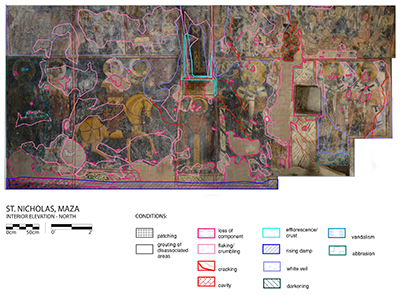 Cristina Stancioiu continued research and writing towards her new project, Art and Identity in Eastern Europe, 14th-17th Centuries: Wallachia and Moldavia in Context, a book aiming to reconsider eastern European architectural and artistic traditions embodied by late medieval monuments from Moldavia and Wallachia (modern-day Romania), and to reassess their relevance to the artistic traditions of the Byzantine and Ottoman Empires, and of the Balkan peninsula. While summer field work was halted due to the global pandemic, work on the digital humanities project Salvaging Crete: Late Byzantine Churches and the Legacy of Painter Ioannis Pagomenos, focused on cataloging and assessing the current physical condition and states of conservation of eight medieval monuments surveyed, measured, and photo-documented in 2019. On campus, Prof. Stancioiu remains an active contributor to the College Curriculum and an advocate for undergraduate research; she coordinated the Art History Senor Colloquium Spring, and joined the Center for the Liberal Arts in Fall 2020
Cristina Stancioiu continued research and writing towards her new project, Art and Identity in Eastern Europe, 14th-17th Centuries: Wallachia and Moldavia in Context, a book aiming to reconsider eastern European architectural and artistic traditions embodied by late medieval monuments from Moldavia and Wallachia (modern-day Romania), and to reassess their relevance to the artistic traditions of the Byzantine and Ottoman Empires, and of the Balkan peninsula. While summer field work was halted due to the global pandemic, work on the digital humanities project Salvaging Crete: Late Byzantine Churches and the Legacy of Painter Ioannis Pagomenos, focused on cataloging and assessing the current physical condition and states of conservation of eight medieval monuments surveyed, measured, and photo-documented in 2019. On campus, Prof. Stancioiu remains an active contributor to the College Curriculum and an advocate for undergraduate research; she coordinated the Art History Senor Colloquium Spring, and joined the Center for the Liberal Arts in Fall 2020
Sibel Zandi-Sayek concluded her term as Department Chair of Art & Art History. She also completed a three-years term as Book and Exhibition Reviews Editor with the International Journal of Islamic Architecture, a bi-annual publication dedicated to new perspectives in architectural and urban history and design in the Islamic World and within global Muslim diasporas. Additionally, she contributed a co-authored essay, “Material Culture,” to A Compendium of Architectural History published in Turkish (Ankara: METU Press, 2019); was invited to give a talk, “Urban Cartography in the Nineteenth-Century Ottoman Empire,” at Rice University’s School of Humanities Research Center; and had an abstract on “The International College of Smyrna: Missionary Encounters in Ottoman Lands” accepted for the SAH annual meetings.














